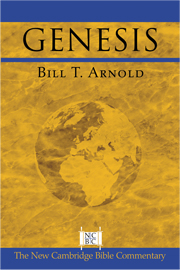Book contents
- Frontmatter
- Contents
- List of Supplementary Sections
- Preface
- A Word about Citations
- Abbreviations
- I INTRODUCTION
- II SUGGESTED READINGS ON GENESIS
- III COMMENTARY PART ONE: THE PRIMEVAL HISTORY – GENESIS 1–11
- IV COMMENTARY PART TWO: ANCESTRAL NARRATIVES – GENESIS 12–50
- Scripture Index
- Extrabiblical Texts Index
- Author Index
- Subject Index
- References
III - COMMENTARY PART ONE: THE PRIMEVAL HISTORY – GENESIS 1–11
Published online by Cambridge University Press: 05 June 2014
- Frontmatter
- Contents
- List of Supplementary Sections
- Preface
- A Word about Citations
- Abbreviations
- I INTRODUCTION
- II SUGGESTED READINGS ON GENESIS
- III COMMENTARY PART ONE: THE PRIMEVAL HISTORY – GENESIS 1–11
- IV COMMENTARY PART TWO: ANCESTRAL NARRATIVES – GENESIS 12–50
- Scripture Index
- Extrabiblical Texts Index
- Author Index
- Subject Index
- References
Summary
GENESIS 1:1–2:3 CREATION OVERTURE
(1:1) In the beginning when God created the heavens and the earth,
(1:2) the earth was a formless void and darkness covered the face of the deep, while a wind from God swept over the face of the waters.
(1:3) Then God said, “Let there be light”; and there was light.
(1:4) And God saw that the light was good; and God separated the light from the darkness.
(1:5) God called the light Day, and the darkness he called Night. And there was evening and there was morning, the first day.
(1:6) And God said, “Let there be a dome in the midst of the waters, and let it separate the waters from the waters.”
(1:7) So God made the dome and separated the waters that were under the dome from the waters that were above the dome. And it was so.
(1:8) God called the dome Sky. And there was evening and there was morning, the second day.
(1:9) And God said, “Let the waters under the sky be gathered together into one place, and let the dry land appear.” And it was so.
(1:10) God called the dry land Earth, and the waters that were gathered together he called Seas. And God saw that it was good.
[…]
- Type
- Chapter
- Information
- Genesis , pp. 27 - 124Publisher: Cambridge University PressPrint publication year: 2008
References
- 1
- Cited by



